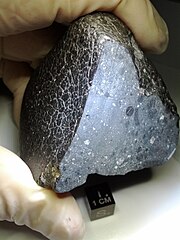| Martian meteorite (SNC meteorites) | |
|---|---|
| — Clan — | |
 Martian meteorite EETA79001, shergottite | |
| Type | Achondrite |
| Subgroups |
|
| Parent body | Mars |
| Total known specimens | 277 as of 15 September 2020[update][1] |
 | |
A Martian meteorite is a rock that formed on Mars, was ejected from the planet by an impact event, and traversed interplanetary space before landing on Earth as a meteorite. As of September 2020[update], 277 meteorites had been classified as Martian, less than half a percent of the 72,000 meteorites that have been classified.[1] The largest complete, uncut Martian meteorite, Taoudenni 002,[3] was recovered in Mali in early 2021. It weighs 14.5 kilograms (32 pounds) and is on display at the Maine Mineral and Gem Museum.
There are three groups of Martian meteorite: shergottites, nakhlites and chassignites, collectively known as SNC meteorites. Several other Martian meteorites are ungrouped. These meteorites are interpreted as Martian because they have elemental and isotopic compositions that are similar to rocks and atmospheric gases on Mars, which have been measured by orbiting spacecraft, surface landers and rovers.[4][5] The term does not include meteorites found on Mars, such as Heat Shield Rock.
- ^ a b "Search results for 'Martian meteorites'". Meteoritical Bulletin. Meteoritical Society. Retrieved 27 April 2020.
- ^ Staff (January 3, 2013). "Researchers Identify Water Rich Meteorite Linked To Mars Crust". NASA. Archived from the original on May 29, 2018. Retrieved January 3, 2013.
- ^ Baker, Harry (2021-09-02). "World's largest Martian meteorite goes on display". Lives Science. Retrieved 2021-12-15.
- ^ Treiman, A.H.; et al. (October 2000). "The SNC meteorites are from Mars". Planetary and Space Science. 48 (12–14): 1213–1230. Bibcode:2000P&SS...48.1213T. doi:10.1016/S0032-0633(00)00105-7.
- ^ Webster, Guy (October 17, 2013). "NASA Rover Confirms Mars Origin of Some Meteorites". NASA. Retrieved October 29, 2013.